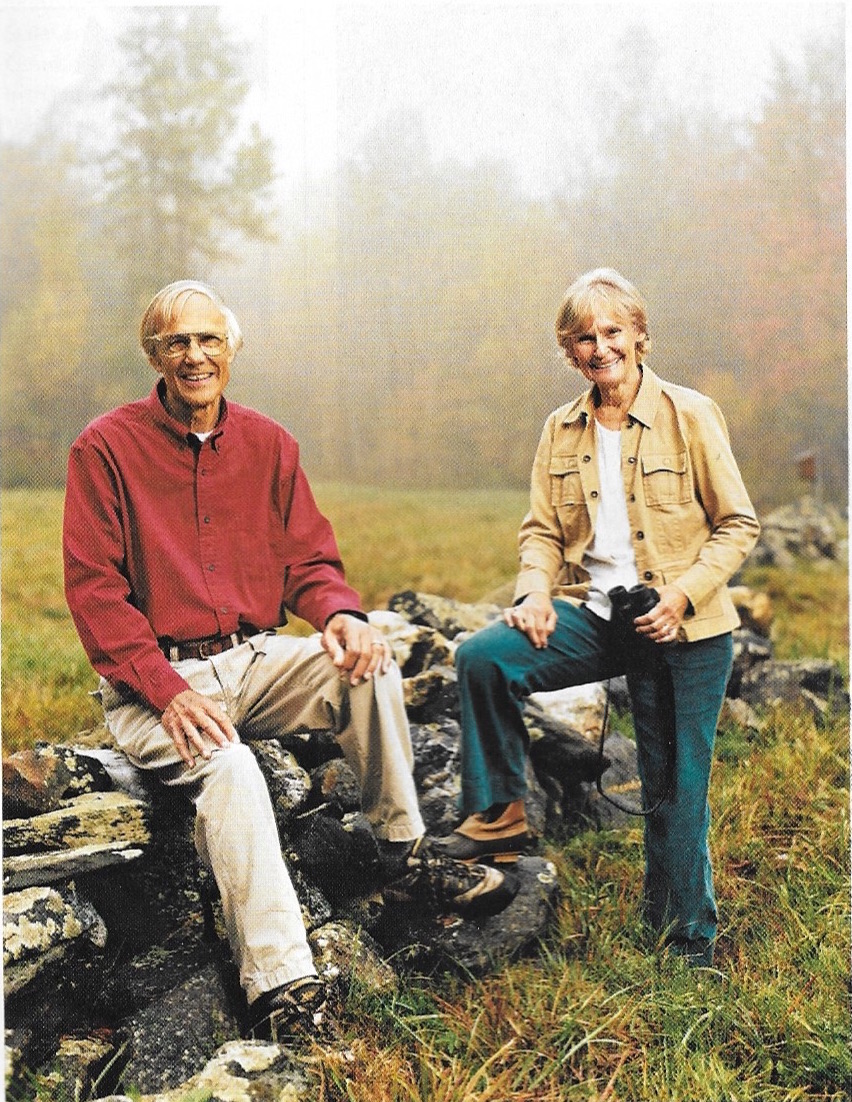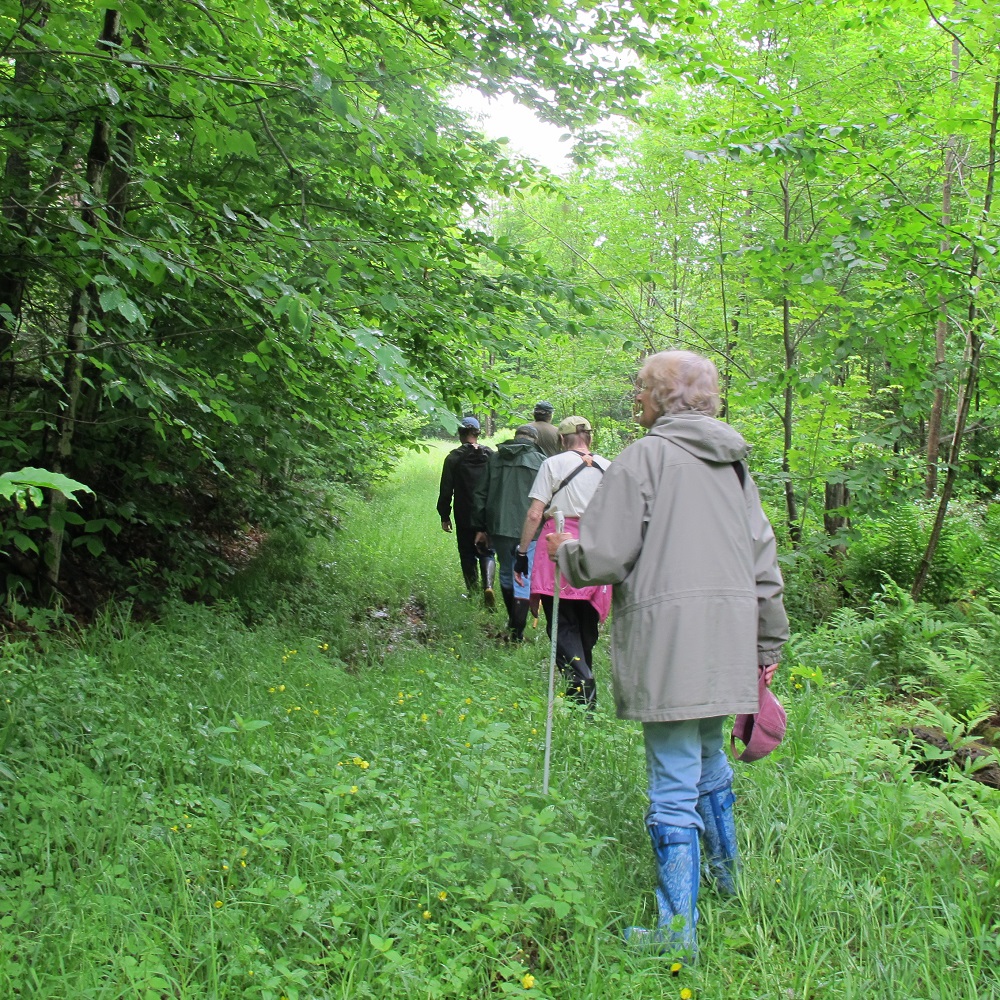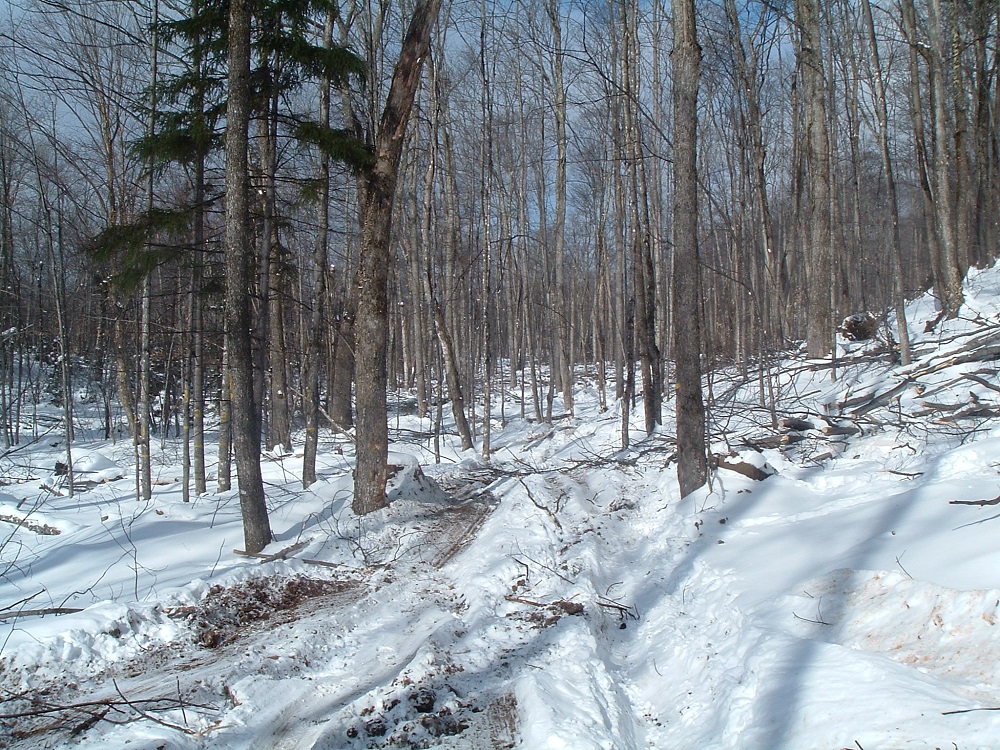Northeastern Finalist: The Parker Family Trust of Vermont
What makes them outstanding?
The Parker Family Trust (Peter & Julie Parker) promote outstanding forest stewardship by example. They initially acquired 187 acres in 1981 and enrolled the woodland in both ˜Tree Farm’ and the Vermont Current Use Program shortly thereafter. Four adjacent parcels were added over the next 15 years and their ownership now totals 560 acres.
Peter and Julie are committed
to long term, sustainable stewardship of their land. They have developed and followed Forest
Management Plans for 35+ years, actively promoted tree farming/forest
management to their neighbors, and kept up to date with forestry issues.  Their land is open for hunting, hiking, x-c
skiing, birding, and all non-motorized use.
Peter annually mows access roads and forest openings and has done a
considerable amount of timber stand improvement through firewood harvests. Wildlife habitat improvement practices
include ongoing apple tree release, retention of den trees and mast species,
and creation of 'early successional' patches for songbird habitat. In 1982 an ongoing growth study on a White
pine plantation was started, and six permanent CFI growth plots were
established in 2001. An initial Audubon
survey was done 2007, and songbirds are now monitored twice each summer along
an established ˜trail’ through various habitat types within their
woodland. The Parkers have hosted
meetings for Vermont Coverts, woodland succession planning, chainsaw safety
training, and wild apple tree maintenance.
In 2017 a Conservation Easement was granted to VT Land Trust to ensure
the property remains undeveloped in perpetuity.
Their land is open for hunting, hiking, x-c
skiing, birding, and all non-motorized use.
Peter annually mows access roads and forest openings and has done a
considerable amount of timber stand improvement through firewood harvests. Wildlife habitat improvement practices
include ongoing apple tree release, retention of den trees and mast species,
and creation of 'early successional' patches for songbird habitat. In 1982 an ongoing growth study on a White
pine plantation was started, and six permanent CFI growth plots were
established in 2001. An initial Audubon
survey was done 2007, and songbirds are now monitored twice each summer along
an established ˜trail’ through various habitat types within their
woodland. The Parkers have hosted
meetings for Vermont Coverts, woodland succession planning, chainsaw safety
training, and wild apple tree maintenance.
In 2017 a Conservation Easement was granted to VT Land Trust to ensure
the property remains undeveloped in perpetuity.
Tree Farmer Story
Our passion for forest stewardship was not on the radar during the early years of rearing our daughters in Chicago and California but arose out of the uncanny New England overlap in Julie’s and Peter’s mid-western backgrounds.
Peter’s father, a Dartmouth graduate from Rhode Island, built a camp on a pristine New Hampshire lake that became the family’s summer haven, still attracting great grandchildren almost 100 years later. Julie’s history is rooted in Vermont, where generations dating back to the Revolution settled in the town of Wallingford and the lush Otter Creek Valley nearby. Both families headed in the summer to these two favorite spots. Hills and woodlands rather than city hubbub left an indelible mark on Peter and Julie’s hearts.
Meeting at Middlebury College and marrying after graduation, we reinforced each other’s love of the rural life despite urban Detroit and Chicago childhoods. Approaching retirement we sought a change from city living that could give us a Vermont experience with a hands-on connection to our own piece of New England forestland. In 1981 we bought an old hill farm that needed us on the side of the Northfield Range not too far from Middlebury. It came with 187 acres of forestland we knew little about managing. Acquiring the skills and science of stewardship forestry became our new avocation.
Overwhelmed at first we contacted Tom Bahre, Addison County Forester, who gave us elementary but valuable enlightenment on the acreage. He helped us find stone boundary walls, laid out our first forest road as we trooped beside him, explaining the importance of properly drained woods roads to good forest management. After identifying a ten-acre pine plantation we hadn’t noticed, he suggested ˜getting in there’ and pruning the smaller trees to capture the value of clear pine. We had bought a badly neglected piece of timberland but with hard work it had potential. Tom told us to hire a private professional forester to guide the work that lay ahead of us.
Tom had given us an immediate project. Over the next three years Peter and a nephew were in the plantation from morning to night with a ladder and handsaw, pruning 700 pines using a new access road laid out by Bahre. Julie helped supervise along with some pruning and brush dragging. Inspiring us was the trip we had taken to Fred Hunt’s property that had been named Vermont Outstanding Tree Farm of the year in 1981. We came home marveling over his impressive forest with its majestic pines. That visit motivated us to join the Vermont Tree Farm Program and continue attending yearly field trips. In 1989 we became Tree Farm #1042 and were certified in 2006.
The plantation now looked better but the acreage on the west face of the Northfield Range needed significant work. Our property had endless challenges. Pine blister rust had killed some of our best pines so we spent several years eradicating currant bushes that had escaped from early settlers’ plantings. Porcupine damage disfigured areas of sugar maples and a canopy of multi-stemmed aging soft maples was suppressing quality young trees beneath. An ice storm did major damage to our highest acres edging the Braintree Gap. There was an ancient carriage road rising straight up the hillside that had to be discontinued to eliminate erosion damage. We added several truck roads with culverts and good drainage whose new switchbacks followed contours.
After hiring forester Randy Wilcox we really began learning the science of managing our woods. Randy, a tree farm inspector, drew up our management plan and certified us under the Tree Farm program. Our first harvest was a pulpwood thinning with no net revenue. It took ten more years before we had grown marketable timber. Each harvest was designed to improve the stand by thinning poorer quality trees opening the canopy for our better maples, cherry, yellow birch, red oak and ash. Insect infestations worried us but our area had almost no invasives. Peter enjoyed clearing ditches, pruning branches along roads and chain-sawing fallen limbs or defective trees. We prided ourselves on stocking our own woodpile for furnace heat in the basement. Splitting wood was a regular part of ˜life on the tree farm.’
By 1995 we had set up a yearly routine of spending winters in the city and summers and fall in Granville. We try to return for a February break to cross country ski on our woods roads with neighbors and prune a small apple orchard for wildlife. We make cider and crabapple jelly in the fall.
 One of Julie’s favorite
spring activities is the annual walk into our woods led by the Mad River Birder
group to track nesting songbirds.
Vermont Audubon’s Steve Hagenbuch laid out a birding route protocol that
the participants have followed for eleven years, listing between 40 and 45
species identified mainly by song. Julie
is also proud to have attracted dependable nesting pairs of bluebirds after
many early years of failure.
One of Julie’s favorite
spring activities is the annual walk into our woods led by the Mad River Birder
group to track nesting songbirds.
Vermont Audubon’s Steve Hagenbuch laid out a birding route protocol that
the participants have followed for eleven years, listing between 40 and 45
species identified mainly by song. Julie
is also proud to have attracted dependable nesting pairs of bluebirds after
many early years of failure.
Forestry is a long-term business whose rewards can take decades. One of our proudest contributions is acquiring new forest acreage from neighbors who planned to subdivide. Once acquired, 187 acres became 560, immediately incorporated into our forest management plan. This acquisition not only increased our quality timber but also created contiguous land areas for wildlife connectivity, clean water, and carbon sequestration.
Now into our senior years, we realize that the younger generation will soon be in charge. Our three daughters and our grandchildren have had wonderful times at the farm, helping split wood and thin young stands, mowing the fields with our old Ford tractor and skiing and mountain biking. In the fall of 2017 we signed a conservation easement with the Vermont Land Trust which protects 540 of our forested acres.
Realizing that without succession planning a forest can often be broken up by the attraction of subdivision, we have tried to instill in our children a love for family forests, and a knowledge of the practical benefits of forest management for revenue.
Describe any outreach on behalf of sustainable forestry that the Tree Farmer has done
One of our first activities owning our hill farm was holding a seminar and field trip on our land for neighboring forest landowners presented by Tom McEvoy, former UVM Extension Forester, on estate planning. Tom outlined the challenge of owning a land asset, illiquid yet valuable when sold, which creates temptations for inheritors needing cash. A field trip followed his talk.
Next, David Brynn, founder of Vermont Family Forests, brought members onto the property to demonstrate forest management in progress. His focus featured native plants, especially indicator species of good soils like wild columbine. Since that time Audubon’s Steve Hagenbuch set up a birding protocol on our land that the Mad River Birders have followed for 11 years.
In the 1990s we participated in Vermont Coverts (VC) classes, a new organization dedicated to managing ˜Woodlands for Wildlife.’ Since then we have invited other neighbors to attend its yearly training. We invited landowners and friends along our North Hollow road for a woods walk, picnic and talk by VC Director Lisa Sausville. We attended Tree Farm conventions in Burlington, VT and Minneapolis.
In the Autumn 1998 Vermont Woodlands Magazine, Peter published an opinion piece contrasting forest regulation in Vermont with California, a very restrictive state. Audubon Magazine, summer 2008, featured our hill farm as a nesting site for diminishing wood thrush whose winter forest grounds in Belize are being converted to agriculture. Julie and Peter’s article on the history of Old John Vinton hill farm was reprinted in September 2017 Vermont Woodlands Newsletter.
2017 we finalized agreement with Vermont Land Trust for a conservation easement on 540 acres. This easement allows the public to hike, ski and ride but the land, protected in perpetuity, can never be sold for development. Our 2018 Outstanding Vermont Tree Farm sign is posted for passersby.
For the following areas describe how the landowner's management addresses it
 Wood: Following
Forest Plan objectives for growing quality timber and maintaining a
healthy/diverse forest a succession (starting mid-1980s) of timber and firewood
harvests has been completed over all operable and productive areas of the
parcel. Harvest totals since the
mid-1990s now total over 800Mbf and 1300+ cords pulp (firewood.) Most areas are managed following uneven aged
guides, integrating wildlife habitat, water quality, and aesthetics where
appropriate or as needed. All harvests
have had trees marked, were done under written contracts and have had follow-up
inspections to check on erosion control measures and gauge success of
treatments.
Wood: Following
Forest Plan objectives for growing quality timber and maintaining a
healthy/diverse forest a succession (starting mid-1980s) of timber and firewood
harvests has been completed over all operable and productive areas of the
parcel. Harvest totals since the
mid-1990s now total over 800Mbf and 1300+ cords pulp (firewood.) Most areas are managed following uneven aged
guides, integrating wildlife habitat, water quality, and aesthetics where
appropriate or as needed. All harvests
have had trees marked, were done under written contracts and have had follow-up
inspections to check on erosion control measures and gauge success of
treatments.
Water: This woodland is situated in a portion of the headwaters area of the First Branch of the White River in Granville, Vermont. As this woodland was acquired and Forest Plans developed, existing brooks, wet areas, and seeps were noted and mapped. Any ensuing forest road construction and harvest activity in or around these areas since has worked to minimize impact. Much of the harvest activity on Parker Trust land has been done in winter on frozen ground to reduce erosion concerns. An uncut buffer has always been maintained along Thatcher Brook. In 2011 Hurricane Irene caused major damage in Vermont. Many town roads and highways were completely washed away, however the well designed (and maintained) woods roads on Parker’s woodland only sustained minimal damage which was repaired soon after.
Wildlife including threatened and endangered species: Wildlife habitat preservation and enhancement have been an important management objective of the Parker Trust Granville woodlands. Ongoing wild apple tree release, mowing of forest roads and permanent wildlife openings, and retention of healthy mast species and den/cavity trees are ongoing.
The 2007 Audubon assessment noted that the woodland is located in the Atlantic Northern Forest Bird Conservation Region (BCR 14) as delineated by the North American Bird Conservation Initiative (NABCI).
Audubon Vermont has identified the landscape in the proximity of the Parker property as the Battell Forest Bird Hot Block. Recommendations by Audubon Vermont (single tree/small group selection harvests, retention of Yellow birch, and creation of early-successional forest) have since been followed. Our two-acre patch cut near the Braintree Gap is intended to help early-succession bird species. Recently (fall of 2018) a black bear and her three cubs were nightly visitors to two apple trees in the Parker front yard. Many of their visits, along with those of two deer, a raccoon, a porcupine, and a fox, were captured on a game camera.
Recreation and Aesthetics including special sites: Many of the log roads serve as hiking, skiing and horseback riding trails and are used regularly by family and neighbors. The Gap Road (an unimproved town road) bisects the parcel running up through Braintree Gap. It is a main snowmobile trail/route over the Northfield Mtn range in the winter and is used by mountain bikers and 4wd vehicles in summer. Twice each summer a local group of Birder’s meets to walk a trail crossing through several habitats to monitor songbirds.
Numerous Special Sites have been identified, including old sugaring sites, cellar holes, unique geology, special trees/areas, and cultural remnants. These sites have been located with GPS and shown on the Forest map.
Nothing is more enjoyable than returning to Vermont in mid-winter to ski our gently graded woods roads. Gliding along in powdery snow while admiring our trees can’t be beat. We have certain tall, straight favorites and gnarly old ˜sentinels’ we look for every year. Neighbors often join us in the fun. Peter mounted a swing in an old boundary maple by a stone wall in a mowed pasture. This meadow sports a crop of Canada lilies in July. One walk is blue with fall bottle gentian by a brook, another shades white columbine in June.
We welcome licensed hunters. A local family coming for years now trains the younger generation on gun safety. Equestrians thank us for keeping roads cleared.
A historic curiosity on our land is a heavy chunk of drilled ˜Verde Antique’ from a local quarry. Town folk remember stories of its tumbling off a wagon trip over the Braintree Gap after the famous ˜27 flood closed valley access. We also ˜own’ a giant boulder, a glacial erratic larger than a house that former owners traded with their logger neighbor for a bottle of Scotch.


